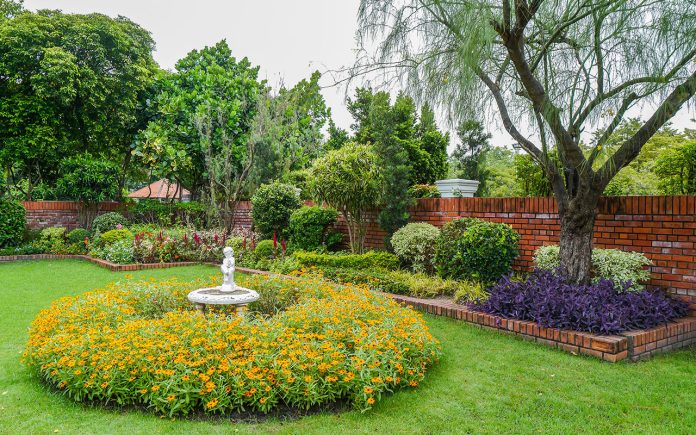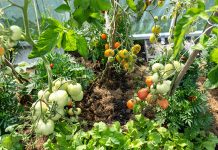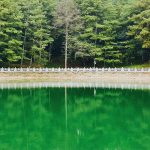In this GreenEcology article we are going to introduce you to several of the different styles of gardens that you can find around the world. Each one has a very characteristic style that we hope you can easily recognize thanks to these simple descriptions that may help you improve your own garden.
Read on and discover 11 types of gardens typical of various parts of the world, their names, characteristics and photos. Which one do you like best?
English Garden
English gardens are characterized by creating environments that are reminiscent of completely natural landscapes. In their effort to achieve this feeling, they work down to the smallest detail to make the gardens adapt to urban environments. One of its main characteristics is the use of water as a central element. Lakes, ponds, and fountains are used as part of a wilder, more natural landscape. The hedges are pruned just enough so that they do not invade too much, but as demarcators of the paths that lead to the discovery of the unique corners of the garden.
French Garden
French gardens are based on geometry. Each element is placed in harmony with the rest in search of precise vanishing points to give a feeling of spaciousness.
Hedges and other plant elements are treated to achieve the desired shape. Water is also a fundamental element in the French garden, used in both large fountains and small fountains. As they are low gardens, they always have an elevated area, preferably a balcony, to be observed in detail.
If you want to put hedges in your garden, we recommend you know which hedges grow the fastest.
Arabian Garden
The Arabs designed these gardens to enjoy the sound of water and long walks surrounded by aromatic and flowering plants. It is a place created for reflection, so its spaces are located behind narrow passages and latticework. Water is the main element of the garden.
The Moorish garden is located in the large central ditches, fountains and fountains, always accompanied by structures such as arched doors and vaults, all decorated with brightly colored tiles and other pieces carved into the stone.
Mediterranean garden
The function of the Mediterranean garden is to protect from the heat, so typical plants of the region that are resistant to heat and lack of water are used. For this reason, trees with globose crowns are sought to get as much shade as possible. It is also common to see fruit trees and rockeries with aromatic plants, such as rosemary. The structural elements are usually painted white.
Japanese Garden
The Japanese garden is one of the most valued for its complexity and search for perfection when it comes to recreating natural areas typical of large forests and mountains in small spaces.
The fundamental elements are rocks, water and vegetation that is allowed to grow naturally. In addition, the architectural elements are introduced into the garden in search of harmony with the landscape. Hence, there is a close relationship between the bridges that cross the lagoons, or the tea houses that are arranged after a walk among the trees and shrubs of the garden. Another particularity are the Zen-like elements, which are placed to maximize the feeling of peace and reflection
Feng Shui Garden
Feng Shui gardens, also known as Zen gardens, seek a balance between buildings and landscape. Therefore, in this search for the meaning and symbolism of each element that composes it, everything must be placed in the right direction and space. In addition, it is sought that each element of the garden is highlighted at the same level as the rest, so we cannot talk about a greater presence of water, rocks or plants, but of a complete harmony in order to achieve a space for reflection and meditation.
Vertical Garden
Created in order to provide a green space in crowded cities, vertical gardens need the same care as conventional ones. However, they are much more versatile when it comes to being installed, both outdoors and indoors.
In the same way, plants in vertical gardens do not suffer when it comes to rooting vertically, it is only necessary to root the plants between the two sheets of fibrous component and fix them to the wall where they are going to be placed. All types of plants can be used, but for beginners, succulent and aromatic plants are recommended.
In this other post from EcologíaVerde we give you ideas and the steps for you to learn how to make vertical gardens.
Sustainable or xerophilous garden
Sustainable gardens seek, through the use of techniques and resources, an efficient method to achieve the development of plants without the need for them to consume a lot of space and without much care. The aim is to achieve the reproduction of the different species of plants, generally native species and xerophilous species, to increase the percentage of humidity in the area. These gardens should not need watering or pruning care, they should be completely self-sufficient with the selection of plants chosen for it.
Rainfed garden
This is another type of garden that is composed entirely of plants capable of adapting to low-irrigation conditions and that only need the contribution of water from rain for their growth. To do this, it is recommended to plow and oxygenate the soil used for its creation to promote plant growth. In the same way, it is common to find desert plants and trees with large or globose crowns in them, as in the Mediterranean garden, to keep the rest of the species that make up the garden from the heat.
Tropical garden
By choosing suitable plants, tropical gardens can be recreated in any area, although it is recommended that they be built in preferably humid areas with stable temperatures. They differ from other gardens by providing dense areas of vegetation, with colorful plants and large leaves that are found in a disorderly way forming small paths in shade. They do not need pruning, as they seek a sense of wild nature. The use of ponds is also recommended.
Water garden
Water gardens are created around a pond, but this doesn’t mean that we can only use aquatic plants. The intention of this type of garden is to create a small aquatic ecosystem where it is natural to also include animal species such as fish (such as carp), small reptiles (such as some species of turtles) and amphibians (such as some species of frogs). In addition to using typical riverside plants, it is recommended to use fleshy and aromatic plants to promote the sensation of freshness.
Finally, we advise you that if you want to set up a water garden at home or add a pond or lake to your garden area, check out this other EcologíaVerde article on +50 aquatic plants, with names, characteristics and photos.
If you want to read similar articles to 11 types of gardens, we recommend you visit our Garden Care category.










